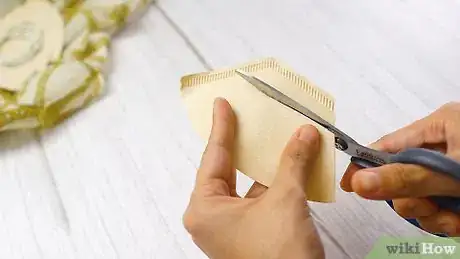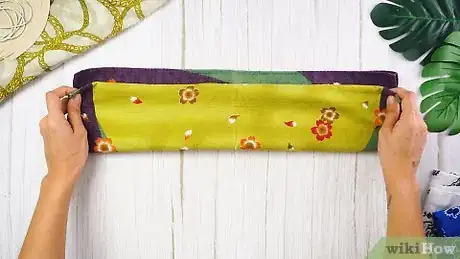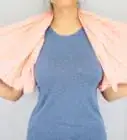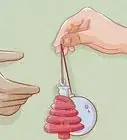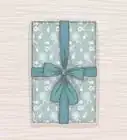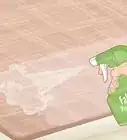This article was co-authored by wikiHow staff writer, Janice Tieperman. Janice is a professional and creative writer who has worked at wikiHow since 2019. With both a B.A. and M.A. in English from East Stroudsburg University, she has a passion for writing a wide variety of content for anyone and everyone. In her free time, you can find her working on a new crochet pattern, listening to true crime podcasts, or tackling a new creative writing project.
There are 10 references cited in this article, which can be found at the bottom of the page.
The wikiHow Video Team also followed the article's instructions and verified that they work.
This article has been viewed 16,050 times.
Learn more...
Scarves are invaluable to have around your home. Depending on how you fold them, they can be made into stylish or protective head and mouth coverings, like a Shemagh scarf. Don’t worry—it only takes a few minutes to fold and repurpose any old scarf or bandana into something new and valuable.
Warning: Cloth masks are ineffective in preventing the spread of more infectious variants of COVID-19, like Delta and Omicron. Use a medical-grade mask to limit the spread and risk of infection from the current dominant variants of the coronavirus.[1]
Steps
Making a Simple Face Mask
-
1Cut a coffee filter in half to create a base for your mask. Search in your pantry for a generic coffee filter that you’d use to brew a pot of coffee. Snip off the top half of the filter with a pair of scissors, then set the bottom half aside.[2]
- The coffee filter acts as an impromptu filter for the mask. If you don’t have any on hand, you can use a scrap of leftover flannel material. For this type of replacement, cut out a strip that’s about 7 in (18 cm) long and 3 in (7.6 cm) tall.[3]
-
2Fold a clean, small scarf in half. Look through your closet for a bandana or other small, square scarf lying around. Fold the fabric in half to create a rectangle, which will serve as the base of your face mask.[4]
- If you don’t have a scarf on hand, check online or in your local fabric store.
Advertisement -
3Place the coffee filter on the center of the folded scarf. Pretend that your folded fabric is divided into thirds: a top, middle, and bottom section. Place your coffee filter in the middle portion of the fabric. Don’t worry if it’s not perfectly even—just try to center it as best as you can.[5]
-
4Tuck the top and bottom thirds of the scarf over the filter. Grab the top edge of the folded scarf and bring it downwards, covering the filter completely. Once you’ve done this, fold the bottom third of the fabric over the previously folded section of scarf. At this point, your mask will look like a thin rectangle.[6]
- It’s okay if your folds aren’t perfectly even! You can redo them as many times as you’d like.
-
5Slide 2 rubber bands onto the folded scarf. Place each rubber band about ⅓ of the way down from both ends of the fabric. Arrange them so they’re around 6 in (15 cm) apart along the folded scarf.[7]
- These bands help secure the mask to your ears.
- If you don’t have rubber bands, you can always use hair ties instead.
-
6Tuck both loose scarf ends around the rubber bands. Take the loose, 2 in (5.1 cm) sections of fabric on either end of the scarf and fold them inwards. Pull both ends toward the center of the mask so they stay put. Don’t worry— you don’t need to sew or tape the fabric in place for this.[8]
-
7Loop the bands behind your ears to secure the mask in place. Center the fabric over your mouth, then begin unfolding your mask so it covers both your nose and chin. Continue rearranging the fabric until you’re fully protected. Now, you’re ready to go out and about![9]
Tip: This is an especially helpful solution during the COVID-19 outbreak. If you don’t have any masks at home, make up 1 of these masks to cover your nose and mouth before you go out grocery shopping.
Tying a Shemagh Scarf
-
1Fold a 43 by 45 in (110 by 110 cm) into a large triangle. Lay out your scarf on a flat surface and angle the fabric so it looks like a diamond. Fold the top or bottom half of the scarf so the corners and edges line up, creating a large triangle.[10]
- Unfortunately, small scarves and bandanas won’t work well for this type of head covering. If you don’t have a large scarf on hand, you can easily find one online or in your local clothing store.
-
2Drape the scarf over your head and pull on 1 end of the fabric. Center the fabric on top of your head like a shawl or hood. Tug on both ends of the scarf to make sure that they’re even, then on the right side of the scarf to make the left side shorter.[11] Don’t pull too much—the left side of your scarf needs to be long enough to wrap beneath your chin.[12]
- Try to cover as much of your heads as possible with the scarf. Ideally, a Shemagh wrap will cover the entire back of your head.
-
3Move the shorter section of scarf to the other side of your head. Cross the left, shorter section of your scarf beneath your chin, then pull it next to your right ear to get it out of the way. You may want to continue holding this portion of scarf in place while you continue folding.[13]
-
4Cover your nose and mouth with the long portion of the scarf. Hold the left, shorter section scarf in place and wrap the right section of scarf around your nose and mouth. Make sure that your nose and mouth are completely covered so you’re totally protected.[14]
-
5Wrap the long section of scarf around the back of your head. Take the long, dangling portion of your scarf and finish looping it around the back of your head. Bring it back to the right side of your head, where the shorter, left section of your scarf is.[15]
-
6Knot the short and long sections of scarf together. Pull on both ends of the scarf so the fabric is taut, but not too tight. Tie both ends together in a basic knot to secure the rest of the scarf in place. At this point, you’re ready go about about the rest of your day![16]
Things You’ll Need
Making a Simple Face Mask
- Coffee filter
- Scissors
- Small scarf
- 2 rubber bands
Tying a Shemagh Scarf
- 43 by 45 in (110 by 110 cm) scarf
References
- ↑ https://health.clevelandclinic.org/are-cloth-masks-enough-against-omicron/
- ↑ https://www.cnn.com/2020/04/04/health/how-to-make-your-own-mask-wellness-trnd/index.html
- ↑ https://www.nytimes.com/article/coronavirus-homemade-mask-material-DIY-face-mask-ppe.html
- ↑ https://www.cdc.gov/coronavirus/2019-ncov/prevent-getting-sick/diy-cloth-face-coverings.html
- ↑ https://www.cdc.gov/coronavirus/2019-ncov/prevent-getting-sick/diy-cloth-face-coverings.html
- ↑ https://www.cdc.gov/coronavirus/2019-ncov/prevent-getting-sick/diy-cloth-face-coverings.html
- ↑ https://www.cdc.gov/coronavirus/2019-ncov/prevent-getting-sick/diy-cloth-face-coverings.html
- ↑ https://www.cnn.com/2020/04/04/health/how-to-make-your-own-mask-wellness-trnd/index.html
- ↑ https://www.cnn.com/2020/04/04/health/how-to-make-your-own-mask-wellness-trnd/index.html
- ↑ http://paracordgalaxy.com/tutorials/pdfs/patterns/shemagh%20tying.pdf
- ↑ https://m.youtube.com/watch?v=BeG8PxJFv5s&t=1m15s
- ↑ https://m.youtube.com/watch?v=BeG8PxJFv5s&t=1m23s
- ↑ https://m.youtube.com/watch?v=BeG8PxJFv5s&t=1m30s
- ↑ https://m.youtube.com/watch?v=BeG8PxJFv5s&t=1m32s
- ↑ https://m.youtube.com/watch?v=BeG8PxJFv5s&t=1m36s
- ↑ http://paracordgalaxy.com/tutorials/pdfs/patterns/shemagh%20tying.pdf
